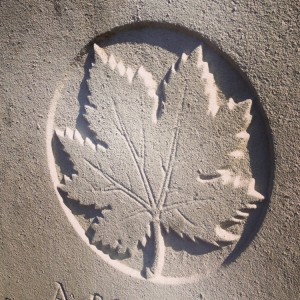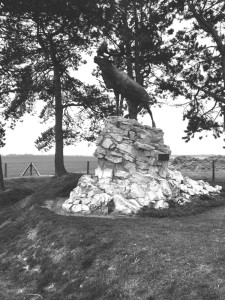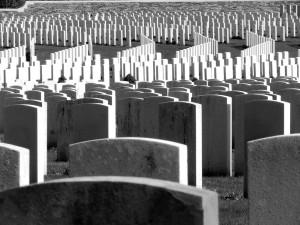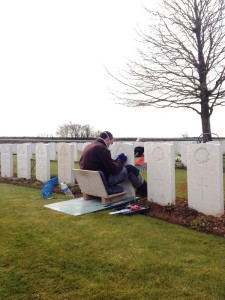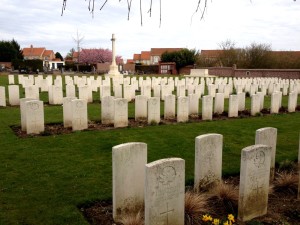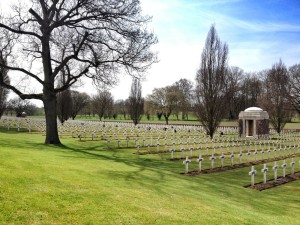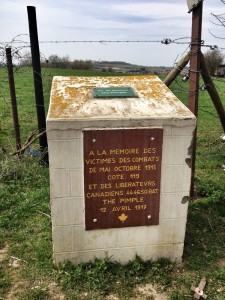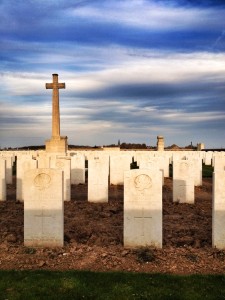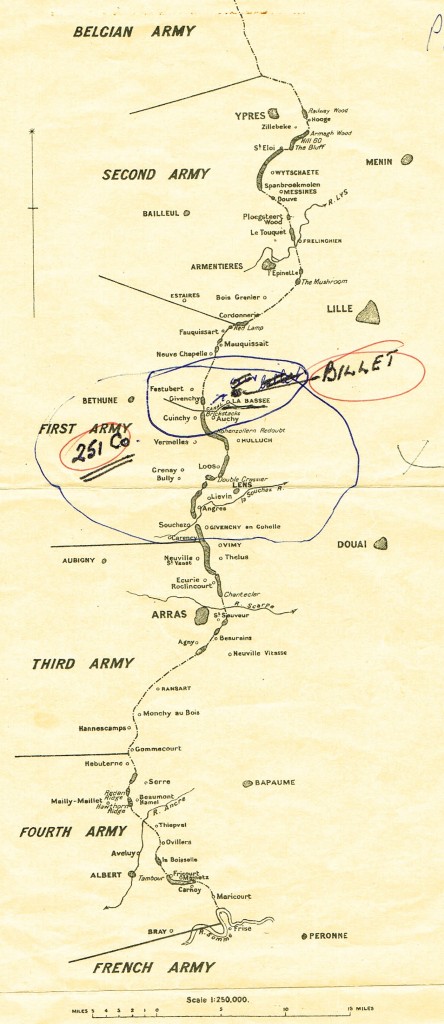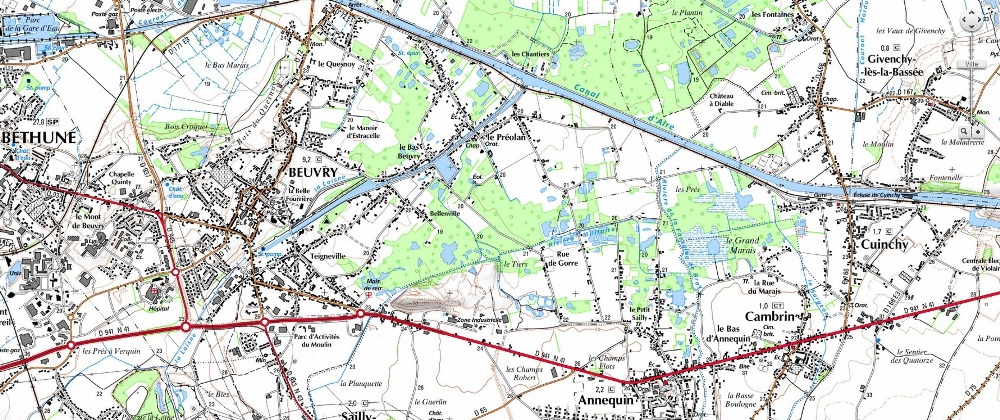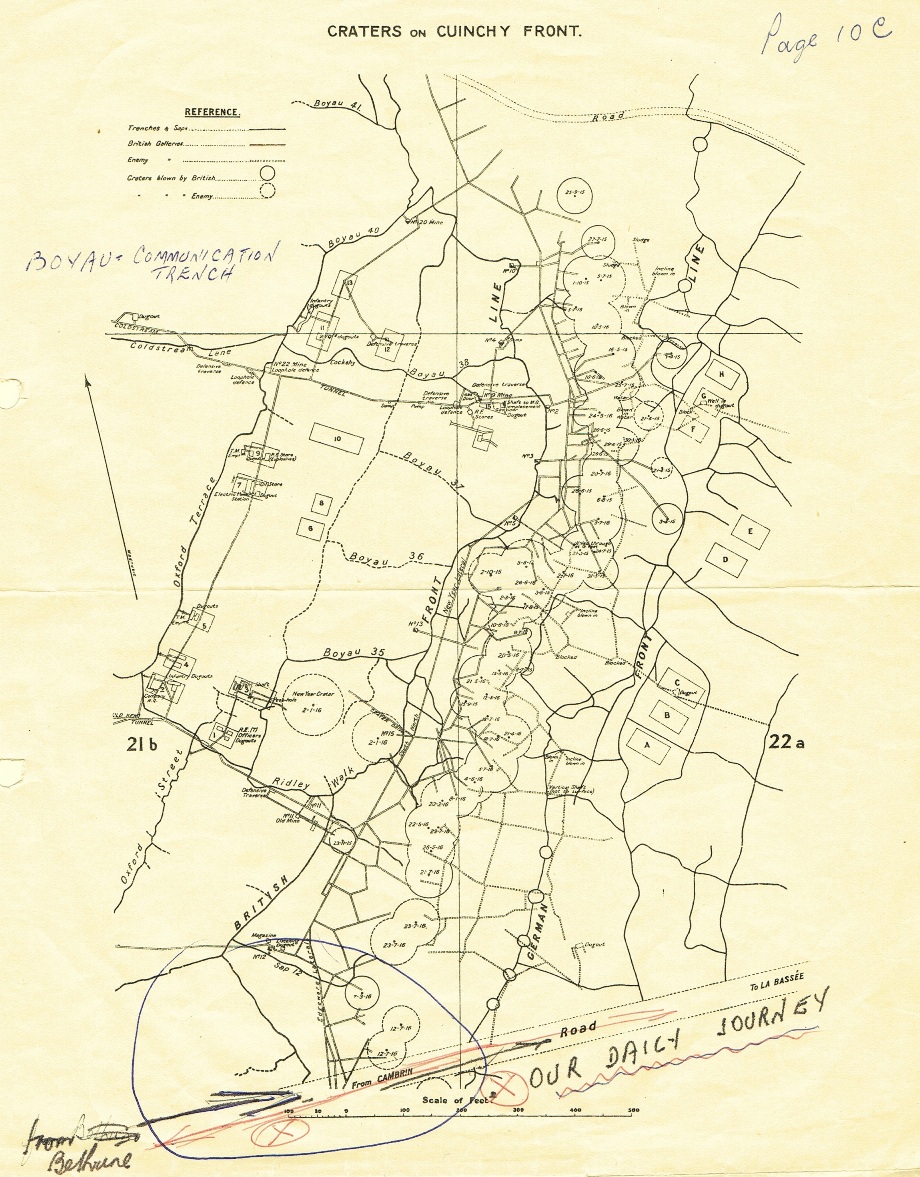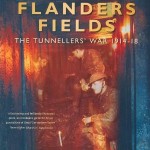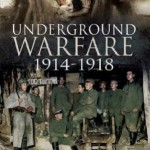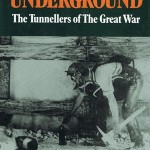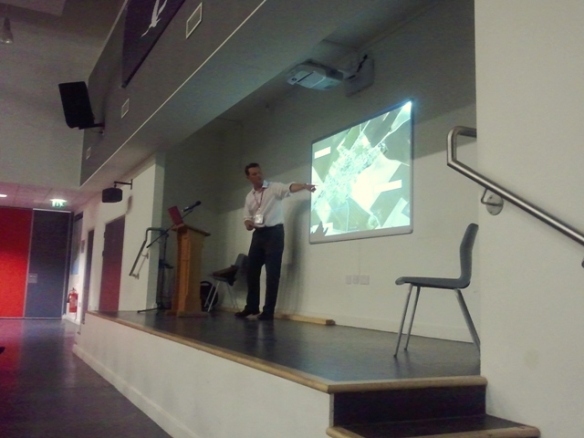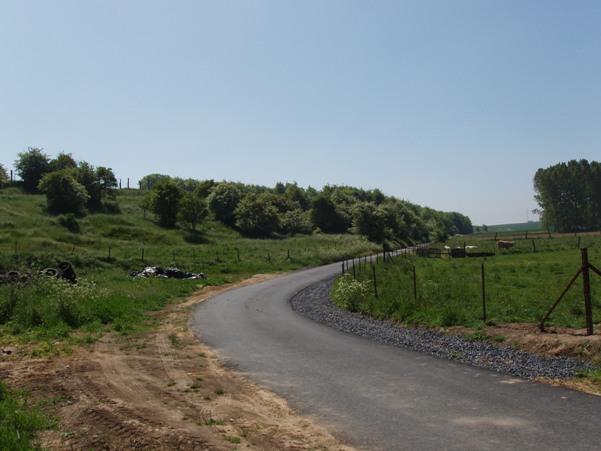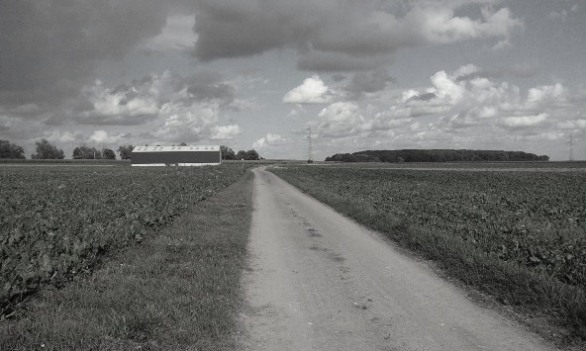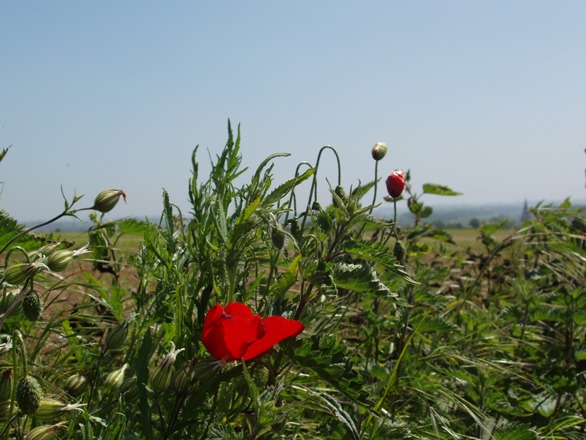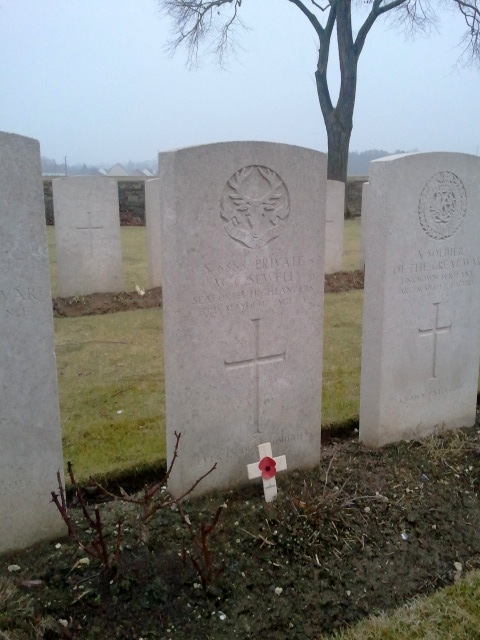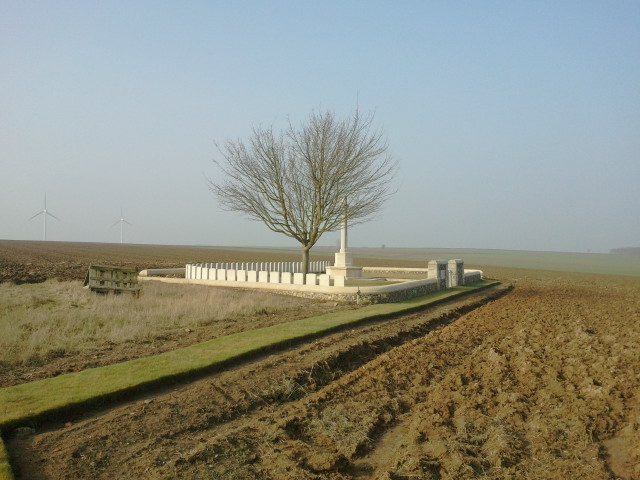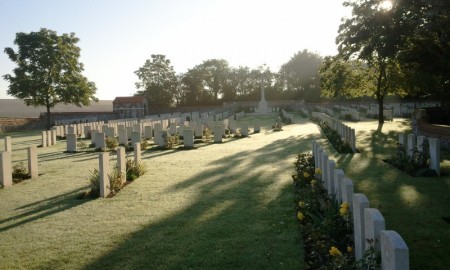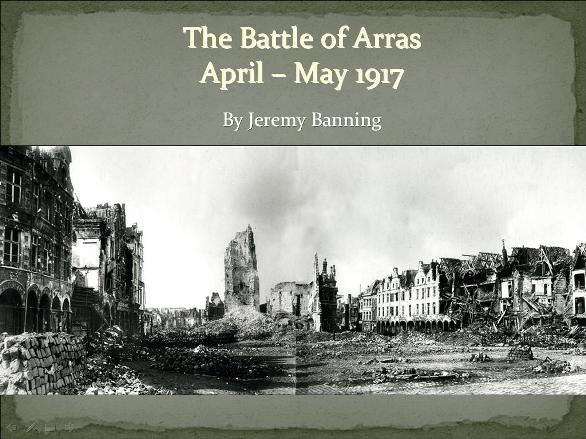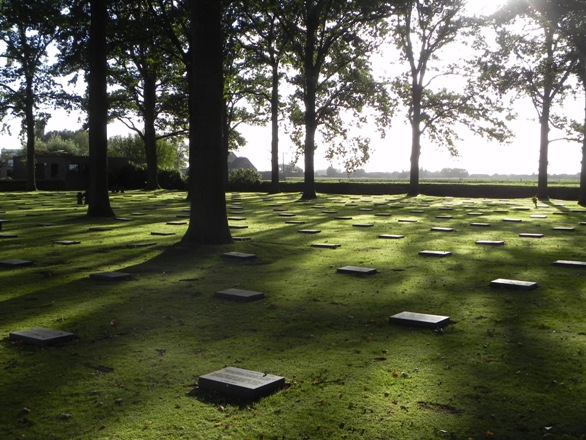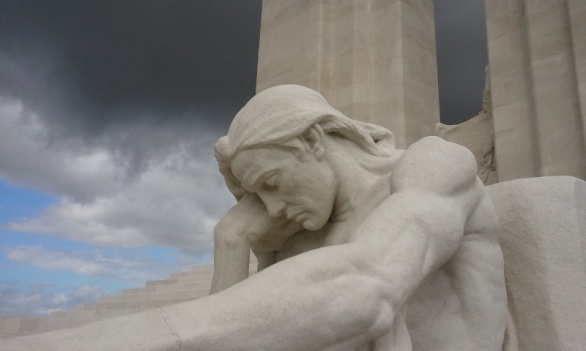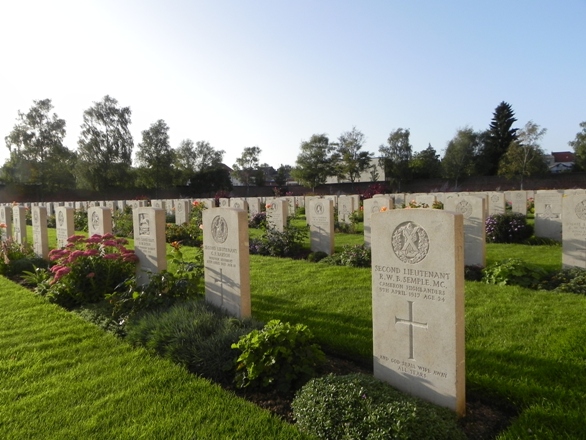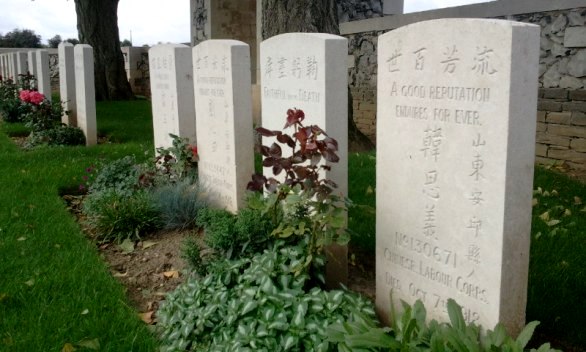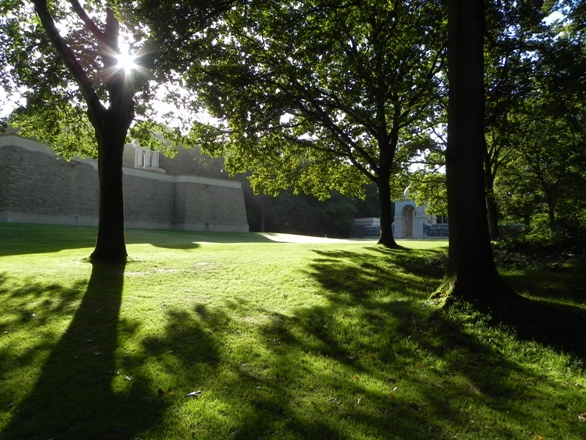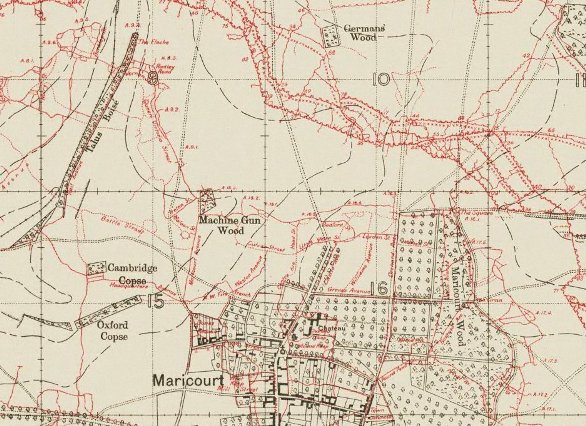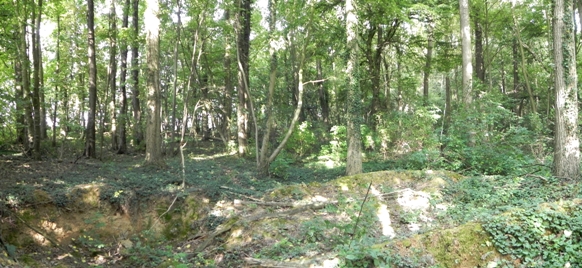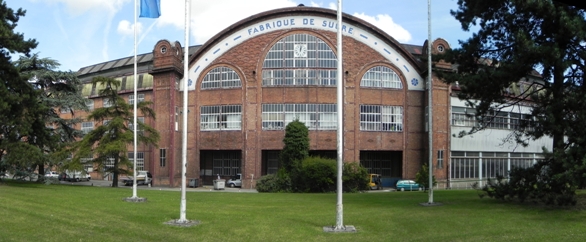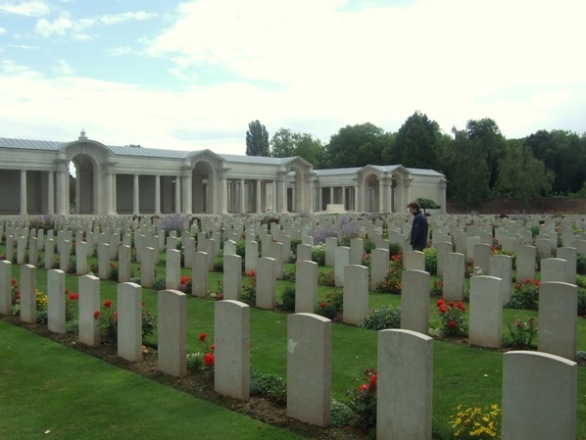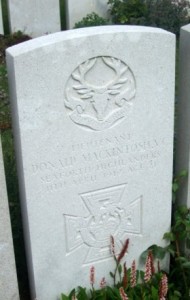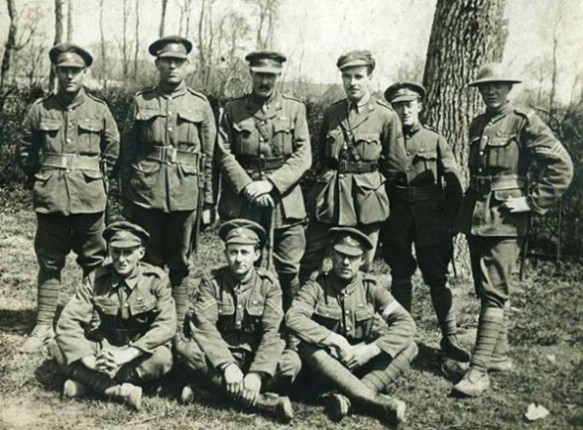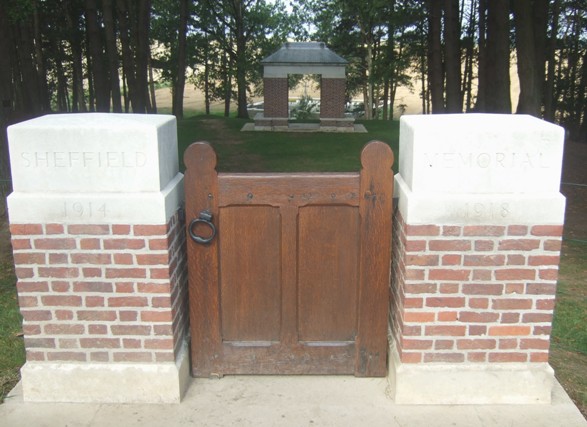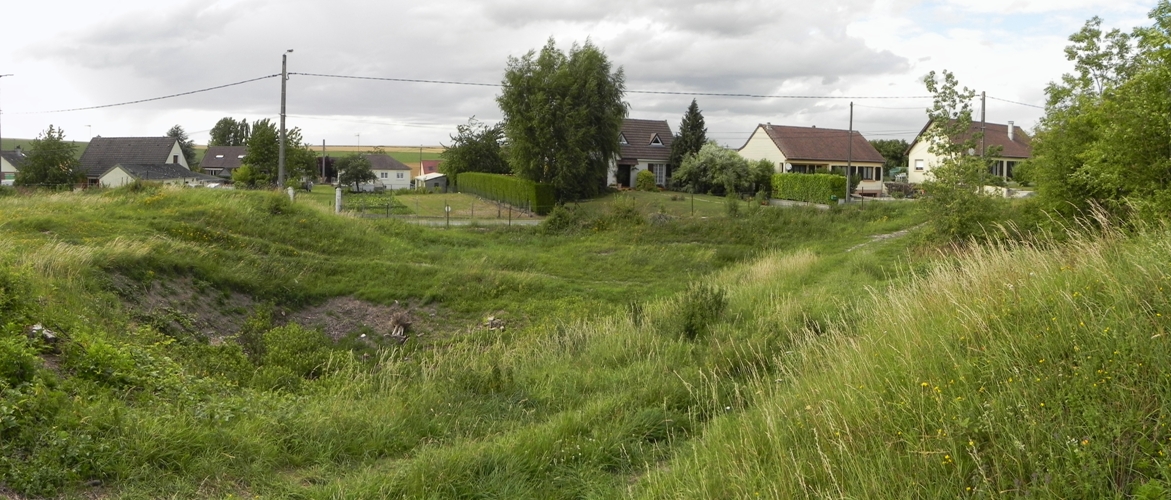Posts Tagged ‘WW1’
On 13 June I gave a talk to 65 students and staff at South Bromsgrove High School on the work of the La Boisselle Study Group. Soon after media coverage began on our work in June 2010 I was contacted by James Wilson from the History department who was keen to learn more and, if possible, visit the site on the annual school battlefield trip.
My talk focussed on our current archaeological work as well as the wartime history of the site. It was satisfying to be given the opportunity to do justice to the resolute French fighting for the village and Granathof in 1914/15. French efforts on the field of battle are often overlooked, something that we are seeking to redress at La Boisselle. I went on to talk about the handover to British troops in summer 1915 and their subsequent efforts, both above and below ground.
Your talk was very well received by both staff and students alike, indeed some of the students have come to find me this morning to ask if we can arrange to come and volunteer at the site; a definite sign that the talk was delivered at the right level. I have to say that it was absolutely what we were looking for, it both enthused and moved the audience through the personal stories you used throughout. I would personally recommend your lecture to anyone who has a interest in the La Boisselle area, or indeed anyone who has an interest in history, a truly captivating talk by an inspirational historian! Mr James Wilson, History Teacher, South Bromsgrove High School
Sadly, this year it was impossible to show the school’s battlefield trip around the site but we aim to do so next year. I have also been asked back to the school to speak next year and look forward to visiting again. My thanks to James Wilson and his colleagues for their generous welcome and feedback. Many thanks to the students for their faultless attention. As a firm believer in the power of education it was immensely rewarding to be able to share my experiences of La Boisselle to school students.
Should you be interested in having me talk at your school or group then please contact me directly.
Having just returned from three days in Arras where I gave a lecture at the Carrière Wellington about the Battle of Arras (April-May 1917) I am heartened by the increase in interest shown in the spring offensive. There is even a plan to tweet updates from the battle which should appeal to those using social media. I thought it a good opportunity to write a short article on the first stage of the battle – the First Battle of the Scarpe which ran from 9 – 14 April 1917. If time and work permits I will do the same for the Second (23/24 April) and Third (3 May) Battles of the Scarpe.
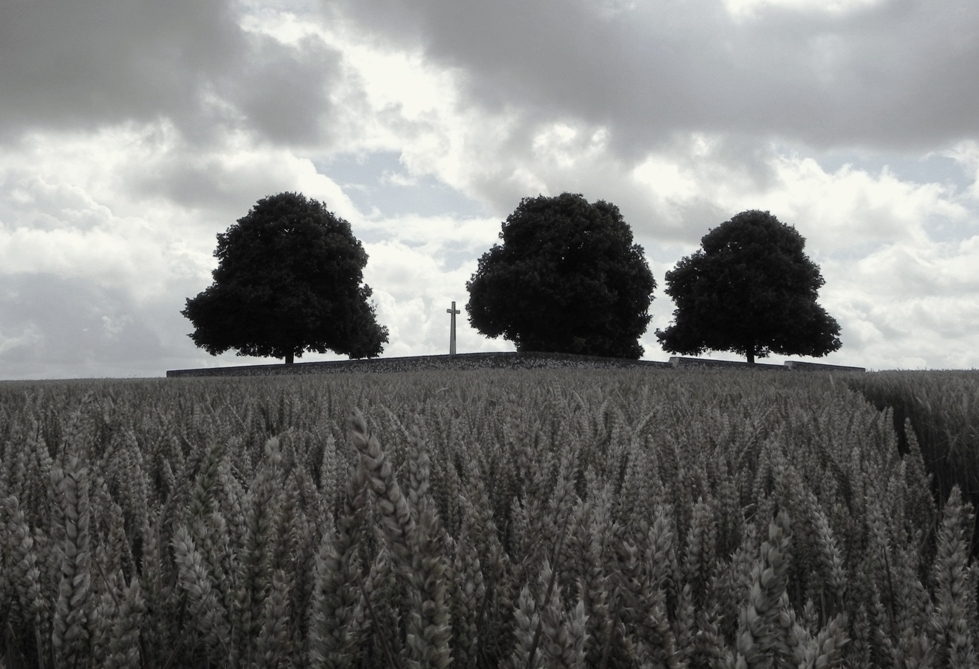
The view from the British trenches at Roclincourt. Highland Cemetery now sits on the position of the German front line. The line was assaulted on the morning of 9 April 1917 by units from the 51st (Highland) Division.
Introduction
Easter Monday, 9 April 1917 was a momentous day which saw the start of the Battle of Arras. It is best known in Canada for the attack and capture by all four Canadian Divisions (operating together as the Canadian Corps) of the previously unconquered heights of Vimy Ridge. It must be remembered that this action, whilst quite rightly lauded was undertaken to protect the northern flank of the main Arras battle front. Sadly, and almost inexplicably the main effort by troops of General Sir Edmund Allenby’s Third Army have been largely neglected by historians, television documentary producers and British battlefield visitors who all head north to Flanders and the blood-soaked fields around Ypres or south to the Somme. I cannot understand this omission as to me, Arras is the most interesting battle of the war offering a major element in the evolution of warfare. By the end of the offensive I would argue that, to many, the prospect of a final victory almost disappears from the Allies’ view.
The British attacks at Arras were part of a larger Anglo-French offensive planned for spring 1917. The author of this scheme was General Robert Nivelle, commander-in-chief of the French armies on the Western Front, who proposed three separate attacks. Two of these astride the Rivers Aisne and Oise would be French led. Great Britain, as the junior partner in the alliance was to launch a major diversionary attack in the north around Arras. It was not what Sir Douglas Haig, commander-in-chief of the British forces wanted, but faced with such a huge French effort there was no other choice but to accept. The German retreat to the pre-prepared positions of the Hindenburg Line (Siegfried Stellung) rendered the attack on the Oise redundant. However, the major offensive on the Aisne and the British diversion at Arras would still go ahead as planned.
9 April 1917 – the opening day
Easter Monday, 9 April 1917 was, in the main, a great success for the attacking British and Canadian forces. Despite the unseasonal sleet, snow and severe cold the Canadian Corps captured the vast majority of Vimy Ridge and British advances to the south were also impressive. An advance of over three and a half miles was achieved by the 9th (Scottish) Division and the ‘leapfrogging’ 4th Division who captured the village of Fampoux. This advance was the longest made in a single day by any belligerent from static trenches.
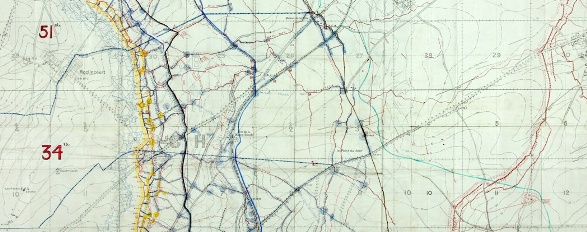
An extract from XVII Corps battle plan showing objectives for the 34th Division including the Point du Jour. Ref: WO153/225. Copyright National Archives & reproduced with their permission.
South of the river attacking British divisions also fared well with Observation Ridge and Battery Valley captured. However, the planned capture of the village of Monchy-le-Preux on its hilltop plateau and Guémappe were not realised. Moving south of the Arras-Cambrai road the successful capture of The Harp and Telegraph Hill can also be viewed as particular triumphs. However, south of the Roman road the British were now attacking the newly constructed Siegfried Stellung (known to the British as the Hindenburg Line). The intelligent siting and design of the Hindenburg Line, coupled with the inability of British artillery to destroy barbed wire sufficiently made the attacks in the south a costlier and much more difficult task. Neuville Vitasse was captured but the two divisions to the south of the village suffered grievously in their attacks.
The night of 9 April saw Germany’s fate in the balance. If British success could be exploited then it was very possible a potentially disastrous breach in their line could lead to a full-scale German retreat. Sadly, for the British, the success of 9 April was the zenith of their action at Arras. Disorganization, breakdown of communications, dreadful weather and the perennial problem of moving the artillery forward over heavily bombarded ground resulted in little concentrated action taking place on 10 April. This delay was exactly what the Germans needed – time to reorganize and strengthen their defences.
First Battle of Bullecourt
The next day, 11 April was a pivotal day of fighting. General Sir Hubert Gough’s Fifth Army attacked in the south at Bullecourt. The hastily constructed plan has been to use tanks of the Heavy Branch Machine Gun Corps to crush the thick belts of barbed wire protecting the Hindenburg Line. When these failed to arrive on time Australian troops broke through the wire, fighting their way into the Hindenburg Line. By midday they were faced with the Germans closing in on them on three sides and were forced to retreat across No Man’s Land to their own line. Over 2,000 men were taken prisoner – the largest number of Australians captured in the war.
The Capture of Monchy-le-Preux
The day also saw the capture of Monchy-le-Preux by the infantry of the 15th and 37th Divisions, aided by six tanks. The capture of the village was an unbelievable feat of arms. Astonishingly, many of the attackers had lain out in the cold and snow for two days and it is a credit to their training and the fighting determination of the British Army that their attacks were pressed with such resilience. Despite the undoubted success of the infantry it is the the fate of the cavalry that Monchy has become synonymous with. With the village captured the cavalry were to advance east to the Green Line. However, they were forced back into the village by German machine gun fire where they were subjected to a ‘box barrage’ of artillery. Unable to escape, the narrow streets were clogged with horses and cavalrymen. The latter dismounted; seeking refuge in cellars but the horses could do nothing and were killed in great numbers as shells rained down. The streets of Monchy, full of horse carcasses and the foul residue of high explosive shells and animals are said to have run with blood.
Disaster for the Seaforths
An ominous taste of things for the future conduct of the battle to come was the attack by the 4th Division on the Green Line from Fampoux. At midday the 2nd Seaforth Highlanders and 1st Royal Irish Fusiliers attacked from the sunken lane between Fampoux and Gavrelle . They were spotted whilst forming up by the enemy in Roeux and on the railway embankment and subjected to shellfire. At zero hour, as they advanced over a kilometre of open ground behind a feeble artillery barrage they were hit by heavy machine gun fire from the railway embankment and Chemical Works. The Seaforths attacked with 12 officers and 420 men and suffered casualties of all 12 officers and 363 men. Only 57 men survived this attack unwounded. This action and the casualties from other battalions of Seaforths are commemorated with the Seaforths Cross at Fampoux. Subsequent attacks were similarly costly. Roeux was fast earning a reputation as a fortress village. British attacks were badly planned and not supported by sufficient artillery fire whilst German defences grew in strength.
13 April was a day for fresh troops to take the field in order to carry on the attack. Exhausted and frozen men trudged back to Arras, replaced by units at full strength. By now it was almost definitely too late for the breakthrough that had appeared so possible on the evening of 9 April.
Infantry Hill – the destruction of the Essex Regiment & Newfoundlanders
An attack was planned from the precarious Monchy salient. Just two battalions of men would attack up Hill 100 (named Infantry Hill by the British). Conditions were so bad in the village with the detritus from horse carcasses blocking the narrow roads that the attack was postponed until 5.30 a.m. on 14 April. The plan was to capture Infantry Hill and send out patrols into the Bois du Sart and Bois du Vert to check for enemy. In hindsight this badly planned attack appears highly dangerous, almost suicidal. The Monchy salient was already surrounded on three sides by enemy forces. The attack, carried out by the 1st Essex Regiment and Newfoundland Regiment went in as prescribed. It started well and by 7.00 a.m. it was reported that Infantry Hill had been captured. However, in their first proper use of the new defensive employment of ‘elastic defence’ a German counter attack was delivered with such speed and precision that over 1000 Essex and Newfoundlanders were killed, wounded or taken prisoner. Monchy had been left undefended and was now at the mercy of advancing Germans troops. The situation was only saved by the commander of the Newfoundland Regiment, Colonel James Forbes Robertson who, with eight other men opened rifle fire from the edge of the village. For five hours their fire held back the enemy until fresh troops reached them. These men, known as the ‘Men who saved Monchy’ were all decorated for this action.
It is not the purpose of this brief article to mention every stage of the fighting but to merely pick out some of the more well-known points. Fighting continued on the Wancourt Ridge with the British capture of the remains of Wancourt Tower. Bitter fighting also continued in the Hindenburg Line; the most well-known casualty from these actions was war poet and officer on the 2nd Royal Welsh Fusiliers, Siegfried Sassoon who was wounded on 16 April. With limited piecemeal actions achieving little Sir Douglas Haig now took control, halting these costly and morale damaging attacks until a combined offensive could be made.
This decision marked the end of the first stage of the Arras fighting – the end of the First Battle of the Scarpe. It was now the turn of General Nivelle to launch his attack on the Aisne. After regrouping and with a marked improvement in weather the British attacked again on 23 April – the Second Battle of the Scarpe.
So, on 9 April 2012, ninety-five years after the whistles blew and attack commenced I will be raising a glass to the memory of the men of all nationalities who fought in the battle. Their sacrifice, perseverance and resolution to finish the job are astonishing. My respect grows for them daily. It is up to all of us to ensure that their efforts are not forgotten.
Should you be interested in the Battle of Arras then the book that Peter Barton and I produced, ‘Arras: The Spring 1917 Offensive including Vimy Ridge and Bullecourt’ is still available. I would urge anyone to visit Arras as it is a lovely town with good hotels and restaurants and only an hour’s drive from Calais. The battlefields are quiet and are immensely rewarding to visit. If you have a relative who fought in the battle or are looking for a guide to show you then please contact me. I would be delighted to help.
The Arras Tourist board are running a number of events over April 2012. Details can be found here: http://www.westernfrontassociation.com/attachments/article/2293/Arras_Ceremony_9_April.pdf
From 2 – 4 March I was guiding a private battlefield tour. Late last year I had been asked to compile a report on S/8888 Private William Charles Sewell who served in the 2nd Battalion Seaforth Highlanders. William Sewell went overseas in November 1915, served through the Somme in 1916 and was killed at Roeux during the Battle of Arras on 3 May 1917. As well as compiling a detailed report on William Sewell’s war service I was asked to take his great nephew, Paul Carter with his friends to follow in William’s footsteps from Arras down to the Somme.
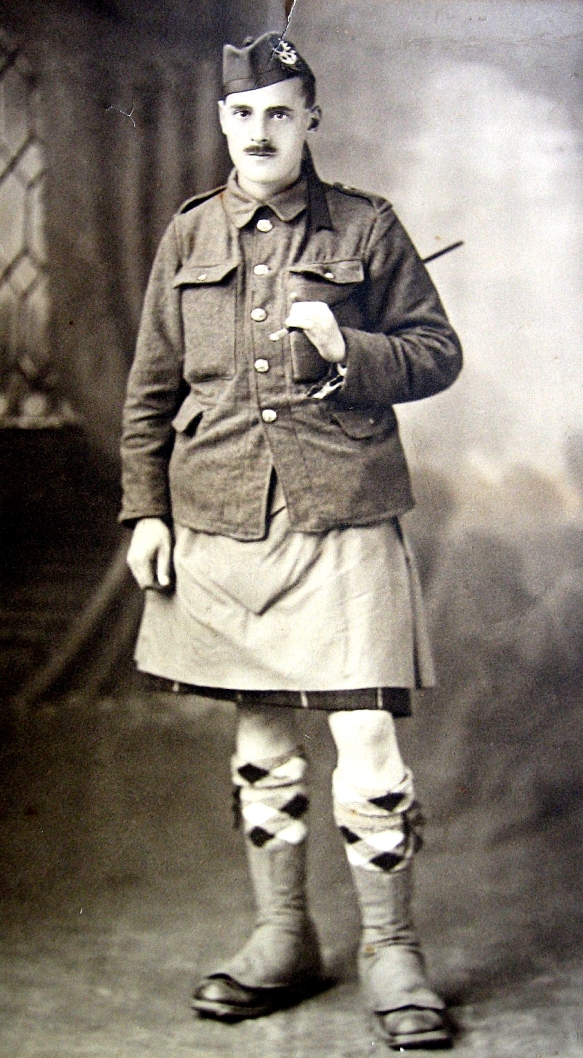
Private William Charles Sewell, 2nd Battalion Seaforth Highlanders. Killed 3 May 1917 during an attack at Roeux during the Battle of Arras. Many thanks to Paul Carter for his permission to use this photo.
Despite a distinct lack of decent weather for the entire trip we had a wonderful time and it was a real honour to be guiding the first member of William Sewell’s family to ever visit his grave. Starting at Vimy Ridge and the Memorial Park we began our tour of the Arras battlefields. After a stop at La Targette for the enormous French and German cemeteries we picked up the Athies road, following in the footsteps of the triumphant 9th (Scottish) Division in their advance on 9 April 1917. After a quick stop at Point du Jour Cemetery and the 9th (Scottish) Division memorial we headed to Fampoux, tracing the route of the 4th Division as they leapfrogged the Scots that day. Stopping at the Seaforths Cross at the Sunken Lane I explained the disastrous attack on 11 April 1917 and read an account of the operation from Private James Stout, a survivor of the attack. As one of those actions that holds a particular fascination for me it was all the more poignant being there with a relative of a soldier who may well have taken place in that ill-planned venture. The following account provides a bleak picture of subsequent events:
At ZERO Hour (12 noon) 2nd Seaforths and 1st Royal Irish Fusiliers advanced, the former on a 3 company front, the latter on a 2 company front. The 2nd Seaforth Highlanders’ objective was the cross roads I.13.a.9.3, exclusive to cross roads I.7.a.4.3 exclusive. Immediately these two battalions advanced, they came under a very heavy machine gun fire from the INN, CHEMICAL WORKS, STATION, CHATEAU and Railway Embankment. The whole ground in Squares H.12 and 18 appeared to be swept by machine gun fire.
At the same time a barrage was put down on FAMPOUX and East of the SUNKEN Road where the remaining two battalions were assembling. This machine gun fire very soon thinned the advancing lines but the troops continued to advance.
On the left, part of a company of the 2nd Seaforth Highlanders entered a new trench some 150 to 200 yards west of the 1st objective, about I.7.c.5.9.
This party under an officer [Lt Donald Mackintosh] maintained itself in the trench for some time, until its ammunition was exhausted, when they were forced back by a counter attack and only a few returned. The remainder, including the officer who is missing, were either killed or wounded, and left in this trench.
The heavy machine gun fire maintained by the enemy made it impossible to obtain information regarding the course of the action but it required no report that a single wave of 400 men who had to advance an average distance of 400 yards with a Battalion front of 1100 yards could not obtain their objectives in face of such machine gun fire and rifle fire.
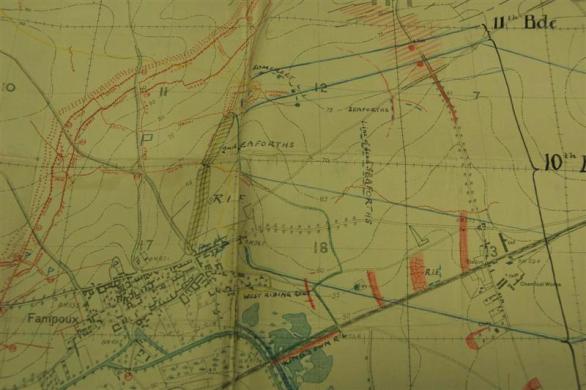
Map extract from 10th Brigade war diary showing 'line of dead Seaforths'. Ref: WO95/1479 10th Infantry Brigade War Diary. Copyright National Archives & reproduced with their permission.
After the debacle of 11 April 4th Division went back for some rest. Their next large-scale attack was the fighting at Roeux on 3 May. It was during this fighting that William Swell was killed. Starting next to the A1 motorway at Crump Trench Cemetery we followed the battalion through their part in the battle. The following map shows the objectives, named respectively the BLACK, BLUE and RED Lines. The total advance was so far as the 4th Division was concerned was to cover a distance of 2500 yards, including:
- The capture of the Northern portion of the village of ROEUX, including the CHEMICAL WORKS and STATION buildings.
- The capture of the trench system on the high ground near HAUSA and DELBAR Woods, and finally
- The piercing of the defences round PLOUVAIN, which were partially wired.
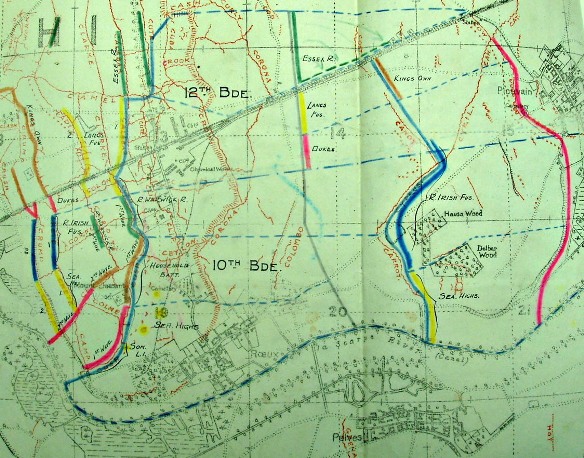
3 May 1917: the 4th Division's attack plan for Roeux . Positions for the 2nd Seaforths can be seen marked in yellow. Ref: WO95/1446 4th Division War Diary. Copyright National Archives & reproduced with their permission.
Of the attack, the war diary notes:
3 May – Zero hour 3.45am when a heavy bombardment of enemy’s position started, lasting for half an hour. Barrage then crept forward very slowly. Battalion left their trenches at 4.30am, being in support to the Household Battalion who were to capture the cemetery north of ROEUX. The Royal Warwickshire Regiment were on the left of the Household Battalion and Royal Irish Fusiliers on left of Seaforths, support to Royal Warwickshire Regiment. 1st Somerset Light Infantry were on the right and were to capture village of ROEUX. On reaching BLUE Line which was just west of DELBAR WOOD the Battalion moved to their right until left of each wave was opposite NW corner of DELBAR WOOD where a halt was made until ZERO + 85 = 5.10am when they advanced to capture the RED line, east of DELBAR and HAUSA WOOD, and immediately west of PLOUVAIN, through I.21.b. and I.15.d & b. This attack unfortunately failed owing to both flanks being held up and severe losses, and later on the whole Brigade line was forced to withdraw to original front line. The Battalion came back to CRETE Trench. This was the position until dark when the Battalion was sent to relieve the Household Battalion in CEYLON Trench from its junction with CORONA Trench I.19.a.8.7. to its junction with COX Trench I.19.a. 7.3. Company Sergeant Major Fraser was in charge of the line as all officers taking part in these operations had become casualties. The Commanding Officer, Adjutant, Medical Officer and three other officers became casualties of the same shell.
Delbar and Hausa Wood no longer exist. Le Lac Bleu (Blue Lake) now covers the ground on which the woods sat. Unless there is specific personal testimony it is notoriously hard to pinpoint the exact spot that a soldier was killed. However, as most casualties were sustained between the BLUE and RED lines it seems likely that William Sewell was killed in this area. Having followed the route of advance we returned to the ground between Fampoux and Roeux to pay our respects at William Sewell’s grave.
Crossing the Scarpe we drove up in Monchy-le-Preux and up Infantry Hill where I recounted the story of 14 April attack by the 1st Essex and Newfoundlanders and the resulting action of the small band of men who saved Monchy from German recapture. For our last stop of the day we headed to the Arras Memorial to Missing.
Next morning began with a windswept walk on the Hindenburg Line to the quiet delight of Rookery Cemetery and Cuckoo Passage Cemetery, the latter full of men of the Manchester Regiment killed on 23 April 1917.
We then headed back into Arras for a good tour of the underground boves and tunnels at Wellington Quarry. Our brief visit to Arras was now at an end as we headed south down to the Somme battlefields.
Our first stop was the Sheffield Memorial Park and the Gospel Copses at Serre (the 2nd Seaforths held the frontline trenches here in November – December 1915). We then headed to Redan Ridge to look at the part played by the 2nd Seaforths in the opening day of the Battle of the Somme, 1 July 1916. The operation plan was for 11th Brigade to take Munich Trench and then for 10th and 12th Brigades to pass through them at a given time and gain the final objective along the Beaucourt Ridge (2nd Seaforths were part of 10th Infantry Brigade)
The war diary offers the following explanation of events:
Zero at 7.30am. From 5.30am the very intense bombardment concentrated on the German trenches in front. At 7.30am the 11th Brigade moved forward from our front in waves.
By 8.45am no messages had come through from 11th Brigade. Patrols advanced and were met by heavy machine gun fire. Telephone to Brigade HQ was out so two orderlies were sent for orders. As they had not arrived by 9am – the hour appointed for the Battalion advance – the remainder of the Battalion moved forward.
On coming into view of the German trenches the Battalion came under heavy machine gun fire from the front and direction of Beaumont Hamel. After passing the German front, parties pushed forward and reached the third line of trenches. Other parties of our men may have reached Munich Trench but there was no possible communication and none returned.
By this time 11th Brigade had already lost their Brigadier, General Prowse (died of wounds) and all four Commanding Officers (killed). Enemy held first, second and third lines on our left and right. Attempts were made to consolidate the ground gained. Enemy bombed on flanks and the third line was given up at about 1pm.
By 11am there were only 5 officers left with the battalion and casualties were proportionately heavy in the ranks. During the evacuation of the third trench Drummer Ritchie sounded the Charge with the idea of encouraging these waverers who had lost their leaders. This gallant action in addition to his conduct throughout the day gained him the Victoria Cross.
We finally withdrew at about 5pm to original front line positions south of the Quadilateral. At this time there were about 40 men of the battalion left.
The war diary records the following casualties:
| Officers | Other Ranks | |
| Killed | 12 | 59 |
| Died of wounds | 1 | 6 |
| Wounded | 8 | 260 |
| Missing, believed killed | 0 | 1 |
| Missing | 0 | 53 |
| TOTAL | 21 | 379 |
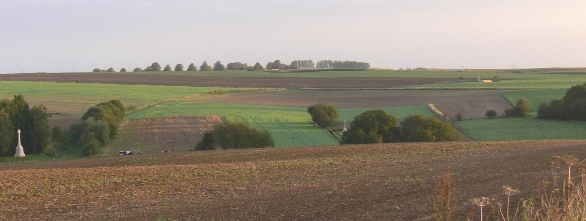
Redan Ridge viewed from a position on the Hawthorn Ridge. The German-held village of Beaumont Hamel is to the right of frame.
Further stops that afternoon included the Sunken Lane at Beaumont Hamel, scene of the infamous attack by 1st Lancashire Fusiliers on 1 July, Newfoundland Memorial Park with its preserved trenches and the Ulster Tower and Thiepval Memorial to the Missing. We finished by following the front line by Authuille Wood to Ovillers, down Mash Valley and then to the hotel at Albert.
Our final day dawned in thick fog which made pointing out sites rather difficult. Beginning with a stop at Fricourt and the Bois Francais we followed the British front line and saw the site of Siegfried Sassoon’s Military Cross action before heading to the site of the Livens Flame Projector site at Mametz. Dropping down to Devonshire Cemetery we headed toward Maricourt and the junction with the French Army on 1 July. Passing Trônes Wood, Guillemont and Ginchy we headed to the desolate fields between Lesboeufs and Le Transloy for our last in-depth look at the part played by the 2nd Seaforths during the Somme battle. Fighting in desperate mud with a thick mist (not unlike the weather on the day we visited) the battalion took place in two attacks in mid-October against German positions in Dewdrop and Rainy Trench. The Battalion war diary recorded the ground conditions in the area:
From Montauban eastwards the whole country is one stretch of absolute desolation – a more gloomy sight I have never seen. The ground is just a maze of shell holes, varying from size of stokes mortar crater to the size of a crater made by a 15-inch.
The attacks on the 14th and 23rd were pressed with utmost gallantry but typical resolute defence from German troops allied to the dreadful ground conditions encountered made any serious advance impossible.
After a walk around Delville Wood and a stop at Flat Iron Copse Cemetery and the Welsh Dragon Memorial at Mametz Wood we ended up at the Glory Hole at La Boisselle where I was able to show them around site and take them underground in W Adit. It had been a real pleasure spending time with these gentlemen. Thanks to Paul Carter and his friends Tim Halliday, Al Kendall and Richard Johnson for making me so welcome. I hope that we can do it again sometime soon – perhaps Ypres next time?
Thank you very much for the wonderful report on my Great Uncle William Sewell and the tailor made trip following in his footsteps 97 years later. Your local knowledge, historical expertise and professional service gave my small group a fantastic tour- better than we could have hoped for. The stories of individual’s personal experiences brought an extra dimension to the trip and brought to life briefly a few of the thousands of names inscribed on memorial walls or grave stones. We all agreed that trip would have been so much less of an event if we had tried to find our own way around, and we would have missed so many significant points. The battlefield overlays and WW1 panoramas were fantastic to relate to as we stood in the centre of all those events and you recounted the events played out. On our journey back there was plenty of talk about the next trip – until then! Paul Carter
I know all four of us found the experience fascinating, thought provoking, educational and frequently moving as well. Your own passion and knowledge of a crucial era in our history was captivating and I am sure like me, the other guys have been singing your praises to those they have talked to about the trip. It certainly was a weekend to remember. Al Kendall
Having mentioned it in a conversation last night I realise that I have not updated my blog for over three months. This is in no way due to laziness on my part. In fact, I have never been busier and am working all hours. Just today I have turned down the chance to author a WW1 book and have been presented with the opportunity of working on what looks like a fascinating WW2 TV project. My blog silence is more due to the fact that the majority of work I am doing is related to upcoming projects, either those definitely agreed and commissioned or others in the pipeline and awaiting the final ‘yes’ or ‘no.’ So, simply put, for much of my work I am unable to provide any details.
Being fashionably late (well over a month) I thought it may be instructive to look back upon 2011 and see if things had moved on from the same point twelve months before. Whilst my accountant may not agree, things have stepped up in almost every department. The most startling event last year was the launching of the La Boisselle Study Group. It was in November 2010 when lecturing on the Battle of Arras at Wellington Quarry that Peter Barton and I were approached by Claudie Llewellyn, owner of the Glory Hole who asked if we would be interested in looking at the site. Naturally we jumped at the chance and my work in 2011 was dominated by the project. It was a relief in June when we could, at last, go public. After many nights burning the midnight oil the website was online. Little did we appreciate the interest in the subject with the BBC article receiving over a million hits and the LBSG the recipient of hundreds of emails. Throughout the traditional battlefield tours season I have been able to take guests to the site for a personal tour and it never fails to astound them. One of the earliest of these was writer Vanessa Gebbie, author of the brilliant novel ‘The Coward’s Tale’, who joined me in April for a tour as we followed the 14th Battalion Welsh Regiment (Swansea Pals) from the Somme to Ypres and back.
I had many trips to the Somme where I was able to enjoy the beauty of this magnificent and fascinating battlefield. In August, in a deviation buy alprazolam paypal from the norm, I headed further south with a client, Roland Parr, to follow in his great uncle’s footsteps. Roland’s Uncle Jack was Corporal John Thomas Davies VC. Amongst the many trips I undertook last year it stood out for me as we diligently traced the retreat of the 11/South Lancs to the point outside Eppeville where Jack performed the heroic action that earned him his Victoria Cross. The latter part of the year was primarily taken up with work at La Boisselle, including our successful week’s archaeological dig in October. Unlike my own site, the LBSG website has continued to grow as we add more and more information.
The year ended well as I was contacted by Wall to Wall Media, producers of the acclaimed ‘Who Do You Think You Are?’ series and asked to film on the new series, showing one of the chosen celebrities around the western front battlefields. The recce in December was cold, bleak and wet whilst we were blessed with cold, clear winter days for the three days filming in January. The programme is due for broadcast in the autumn.
With the build-up to the centenary commemorative period gathering pace I am heartened to see the interest from the public. Some of this may be due to Spielberg’s film ‘War Horse’ and the recent BBC adaptation of Sebastian Faulks’ ‘Birdsong’. Whatever the reason, I cannot think of a point in my lifetime when the public consciousness of the Great War has been so high. It will continue to grow as 2014 looms nearer and the plethora of planned books plus TV and radio programmes come to fruition.
Much of my planned research has been put on hold due to other commitments. It will be good to get back into the archives and I look forward to visiting many regimental museums later in the year. My next talk is a planned 45-50 minute lecture on the Battle of Arras, to take place on 4 April. Having spoken on the subject many times I should have no fear. The twist is that the lecture is to be given in French. Having been invited by the Tourist Office in Arras there was no way I could turn down the opportunity. Sadly, my spoken French is not up to sufficient standard yet so I will be practicing like mad between now and April!
Last Wednesday (19 October) I spoke at my local branch of the Western Front Association. The subject was one dear to my heart – “The Battle of Arras: April-May 1917”. It was the same talk that I gave to the Berkshire branch of the WFA back in April – see this BLOG article. This time I was allowed a bit longer and so spoke for 45 minutes which took us through the reasons for battle, political intrigues, German retreat to the Hindenburg Line, preparations, work of the RE and artillery and then a detailed look, division by division, working down the line on 9 April 1917 – the first day of battle. After a pleasant ten minute break I continued for a further half hour with details of the fighting for Monchy-le-Preux, Infantry Hill, Roeux and the Chemical Works and Gavrelle before culminating in a description of the disastrous 3 May attack – an attack on a 21km frontage in which 5,900 men were killed in a single day.
It was lovely to speak on ‘home’ turf; the branch in Kingswood being a mere ten minute drive from my house. I do my utmost to attend the monthly lectures but work and family life normally get in the way so it was nice to actually make it this time. It was good to see people had driven from Devon and Newport and I thank them for their interest and support. This morning I received a letter from Dr Barry Maule on behalf of the Avon branch.
“I am writing on behalf of the Bristol branch of the WFA to thank you most sincerely for the excellent talk you gave us on Wednesday evening on the Battle of Arras. You probably gathered from the buzz in the room after your talk that it was particularly well received and very much appreciated by those of our members who share your view that the Arras battles deserve to be much better known.
From experience I can always tell when a talk has been well received by our members because they are reluctant to clear off home afterwards, something that was particularly noticeable on Wednesday evening.
I am sure our chairman spoke for everyone in the room when he described your talk as absolutely tremendous.”
I raffled a copy of our Arras panorama volume and raised a nice sum for the La Boisselle Study Group. Many thanks to all who attended for their generosity. Should anyone be interested in hearing this or other talks then please contact me.
A few weeks ago I took a couple, Mac & Marian from New Zealand, around the battlefields. They had asked me to show them around the Western front for three days before catching a train to Paris for the next leg of their trip. What made this trip so special was that we were following Corporal Andrew McDonald, 6th Seaforth Highlanders. Andrew McDonald died of wounds on 13 April 1917 and is buried at Etaples Military Cemetery. His battalion was involved in the opening stages of the Battle of Arras. It is highly probable that he was wounded when the battalion ‘went over the top’ in front of Roclincourt at 5.30am on 9 April 1917. I had previously written about the area in a piece entitled 6th Seaforth Highlanders at Roclincourt – The Battle of Arras, 9 April 1917.
After picking up Mac & Marian at Folkestone we took the tunnel over and then headed along the coast to Etaples. They told me that they had visited Second World War cemeteries before but I could see how moved they were when we pulled up at Etaples. The cemetery, the largest Commission cemetery in France, was designed by Sir Edwin Lutyens. The scale of the place defies belief and really deserves to have more visitors. After visiting Andrew’s grave and laying a small cross – something that Mac had been wanting to do for years – we spent a couple of hours just walking around this vast and sobering cemetery – the final resting place for 11,500 men and women.
Retracing our steps back up the motorway we headed to Ypres where I took them to various spots around the salient including Pilckem Ridge, Polygon Wood, Robertson’s Bridge at Reutel, The New Zealand Division Memorial at Gravenstafel, Tyne Cot Cemetery and finally the German Cemetery at Langemarck. We headed back to our excellent B&B and then back out to Ypres so we could attend the Last Post ceremony at the Menin Gate. We ate in the square before heading back to the B&B for a good sleep after a long day.
The next day was to be spent around the Arras battlefields. After a mammoth breakfast we set off south, firstly stopping at Nine Elms Cemetery at Poperinghe to pay our respects at the grave of David Gallaher, captain of the All Blacks.
We had a quick stop at Peckham and Spanbroekmolen, two of the huge craters formed by the Messines mine explosions on 7 June 1917 before heading south via Ploegsteert and into France to our next stop at La Chapelle-d’Armentières. It was here, at the site of the Railway Salient that Andrew McDonald’s brave actions during a trench raid on 15 September 1916 earned him the Military Medal. I was able to stand Mac at a spot looking down the railway line to where the German salient jutted out into No Man’s Land and explain the events of that night. We then continued south, stopping at Noeux-les-Mines Communal Cemetery & Extension to pay our respects at Marian’s great uncle, David Watson’s grave. He had been killed during the Battle of Loos whilst serving with the 1st Battalion, Cameron Highlanders. Leaving the coalfields of Gohelle behind us we began our look at the Arras battlefields.
I started with a stop at the village of La Targette with its staggering French and German cemeteries. If ever there is a place to fully appreciate the extent of losses suffered by our French allies and German foe then this is it. Neuville St Vaast Soldatenfriedhof has over 44,000 German buried within its grounds – a truly sobering place. We then headed to Vimy Ridge where, after a tour of the trenches, we headed to Walter Allward’s magnificent Vimy Memorial.
Next up was a special visit to the exact spot outside Roclincourt where ‘C’ Company, 6th Seaforths attacked on 9 April 1917. It was in the fields between the British front line and second German line (the area now contains the beautiful Highland Cemetery) that Andrew McDonald most likely received his fatal wound.
After an emotional stop at Highland Cemetery to visit other 6th Seaforth men we continued our tour through St Laurent Blangy and Athies to the Seaforths Cross at Fampoux. We then headed to the infamous village of Roeux (heavily fought over by the 51st Division in April and May 1917) and crossed the Scarpe to Monchy-le-Preux, Infantry Hill and then back down the Arras-Cambrai road to the superb Carrière Wellington tunnels. Our final stop of the day was at the Faubourg d’Amiens Cemetery & Arras Memorial to the Missing where, bathed in evening sunlight, we wandered at our leisure. After a meal in the Grande Place we headed off for a much-needed sleep.
The following morning saw us continue south down to the hallowed ground of the Somme battlefields. Mac & Marian had asked for unusual stops so, en route, we stopped at the quiet Ayette Indian & Chinese Cemetery.
Continuing south we visited Sheffield Memorial Park at Serre where I explained about the destruction of the Pals battalions of the 31st Division on 1 July 1916, the First Day of the Somme. We then headed over the Redan Ridge to Beaumont Hamel where, as well as looking at the disastrous attack by 29th Division troops on 1 July I gave a detailed explanation of the 6th Seaforth’s role in 51st Division’s successful attack on the village bastion on 13 November. We then visited Mailly Wood Cemetery to visit the graves of 6th Seaforths men killed in that attack. Most notably I had wanted them to visit the grave of 2/Lt Donald Jenkins MC. He had won his Military Cross in the same raid that earned Andrew his Military Medal – in fact, both men had crossed No Man’s Land three times bringing back wounded men on each occasion. Undoubtedly, despite the officer/other rank divide there would have been some connection between Andrew and this officer now lying at peace in Mailly Wood Cemetery.
Other stops that afternoon included a good stroll around Newfoundland Memorial Park, the Ulster Tower and Thiepval Memorial to the Missing. Having stopped at Mash Valley I took Mac & Marian on a private tour of the Glory Hole at La Boisselle (http://www.laboisselleproject.com/) before our final stops of the day at the Caterpillar Valley Cemetery for the New Zealand Memorial to Missing from September/October 1916 and the New Zealand Division Memorial at Longueval.

Early evening at Caterpillar Valley Cemetery. A ray of sun pierces through the clouds to strike the ground.
Passing High Wood I was able to point out the position of Seaforth Trench, dug by 6th Seaforths in July 1916 before heading off to our B&B at Flers for a well deserved beer, meal and chat.
The final day dawned with beautiful sunshine and so, rather than dropping Mac & Marian off in Amiens as had been agreed, I took them just down the road to Delville Wood and the South African Memorial. We were the first ones to visit that day and the atmosphere and light were quite superb.
After a circuitous tour to Ginchy, Guillemont and Montauban I stopped at the site of the Carnoy craters to tell them about the successful use of the Livens Large Gallery Flame Projectors employed there on 1 July 1916. Moving on to Amiens, we visited the splendid cathedral before I bade them a fond farewell at the railway station. It was another trip to be remembered with lovely people – thanks Mac & Marian for making it such a great time for me too.
More photographs from this trip can be seen on my dedicated Flickr page: http://www.flickr.com/photos/67774984@N03/sets/72157627598624551/
“Thank you for a fantastic trip in September 2011. We were lucky enough to travel with you for three and a half (far too short) days and experience your enthusiasm and passion for WW1 and the Somme first hand. We needed a lot longer. On your website you mention Corporal Andrew McDonald. He is my husband’s Great Uncle lost in 1917. During our time with you he came back to life and it was marvellous to be able to tread the same ground that he walked and to see similar sights. The report that you provided to us will hopefully inspire some other family members to travel to France and Belgium and to utilise your knowledge and enthusiasm for the Western Front and the Somme. You were willing to take us out of our comfort zone and show us areas, memorials and cemeteries that we had no idea could exist from the smallest to the largest including German, Indian, Chinese, Kiwi, Aussie, French, British, South African, Canadian etc. More than we had hoped for or realised that we would have ever seen. Thank you for your ability to generate interest and create great memories.
We would suggest that anyone who contemplates visiting Gallipoli and the Somme, visit Gallipoli first as the memories of France and Belgium will be stronger than those of Gallipoli. Jeremy was a fantastic guide who took care of us and took us to places we could never hope to see or find on our own. His contacts, his advice, the accommodation he organised and all aspects of the trip were 110%. Thank you for your time and efforts and we both wish you well for the future. Keep guiding.” Marian & Mac Macdonald, Pukekohe, New Zealand
Bespoke battlefield tour walking in the footsteps of Corporal JT Davies VC, 11th South Lancashire Regiment
Earlier this month I spent an enjoyable time on the Somme with a client, Roland Parr, who was following in the footsteps of his great uncle, John Thomas Davies VC, 11th South Lancashire Regiment.
Roland had commissioned me to produce a detailed report on his great uncle in order that other family members could know more about this man, his war and the actions that led to the award of his Victoria Cross. Over the past few months Roland had accompanied me to the National Archives to look at war diaries from Division, Brigade and Battalion level. We also visited the Imperial War Museum to work in the Department of Documents and to have a good look at the new(ish) Lord Ashcroft Gallery which holds the original VC of Jack Davies. It must have been a somewhat surreal experience for Roland to be looking at the actual VC in its hermetically sealed case when he remembers holding the medal as a young boy.
All of this was the precursor to our visit to the battlefields to follow ‘Uncle Jack’ around the western front.
We set out from Peronne and began our pilgrimage at Maricourt, a village that Jack Davies and the rest of the 11th South Lancs would have known well from their time here in 1916. The battalion were the Pioneers to the 30th Division. I had found a map showing the trenches in this sector dug by the battalion during the month of July 1916. I also noted that they had opened out some of the Russian saps dug by men of 183 Tunnelling Company RE. All of these sites could be viewed in the fields in front of us.
We stood at the site of the British front line on the quiet road to Montauban with Machine Gun Wood on our left and Germans’ Wood to our front right and imagined what this scene looked like on 1 July and the subsequent days and weeks as battle moved on in this area.

Panorama from British front line looking towards the village of Montauban on the right hand side - an objective for the 30th Division. Machine Gun Wood can be seen on the left of frame.
After Montauban we stopped at the 18th (Eastern) Division memorial at Trones Wood. The 11th South Lancs had been working in the wood in the latter half of July 1916.
We then spent a pleasant few hours on a tour of the battlefields – all south of the Ancre. Stops included High Wood, Ulster Tower and the Pope’s Nose and the Thiepval Memorial. I was also able to give Roland a good look around the Glory Hole at La Boisselle.
After stocking up on a picnic lunch at the Old Blighty Tea Room at La Boisselle we headed back to Peronne and then down to St Quentin, focussing on the period from the German attack on 21 March 1918 through to the action for which Jack Davies was awarded his VC on the morning of 24 March. We visited the villages of Savy, Roupy and the small site of Epine de Ballon. Jack’s company (unknown) was in one of these locations prior to the German offensive. We then made our way to Fluquieres and from there to the high ground between Aviation Wood and Mill Wood. On the evening of 21 March 1918 the battalion dug and wired a defensive line through here, remaining for nearly 24 hours until on the evening of 22 March the order was given for all troops to withdraw in orderly fashion to Ham. Upon reaching Ham the battalion was told to billet in nearby Eppeville. We had a good look around Ham, visiting the bridge over the Somme Canal blown up by a detachment of Royal Engineers on the morning of the 23rd before driving west to Eppeville itself.

The bridge over the Somme Canal at Ham blown up by a detachment of RE on the morning of the 23 March 1918
This was the village, really no more than one street, intrinsically tied to Jack Davies’s VC story. After stopping at the Sucrerie (ironically now owned by a German company called Südzucker, the largest sugar producer in Europe) we continued west and crossed the railway line, noting the positions held along the line by the battalion.
Finally, we reached the field where two companies of the battalion were almost entirely surrounded on the morning of 24 March 1918. As is the way with so many sights of unimaginable bravery in the Great War there is nothing to mark the site as anywhere special – just a couple of grassy fields next to the road with a man-made lake behind them barring the way to the stream over which the survivors escaped.
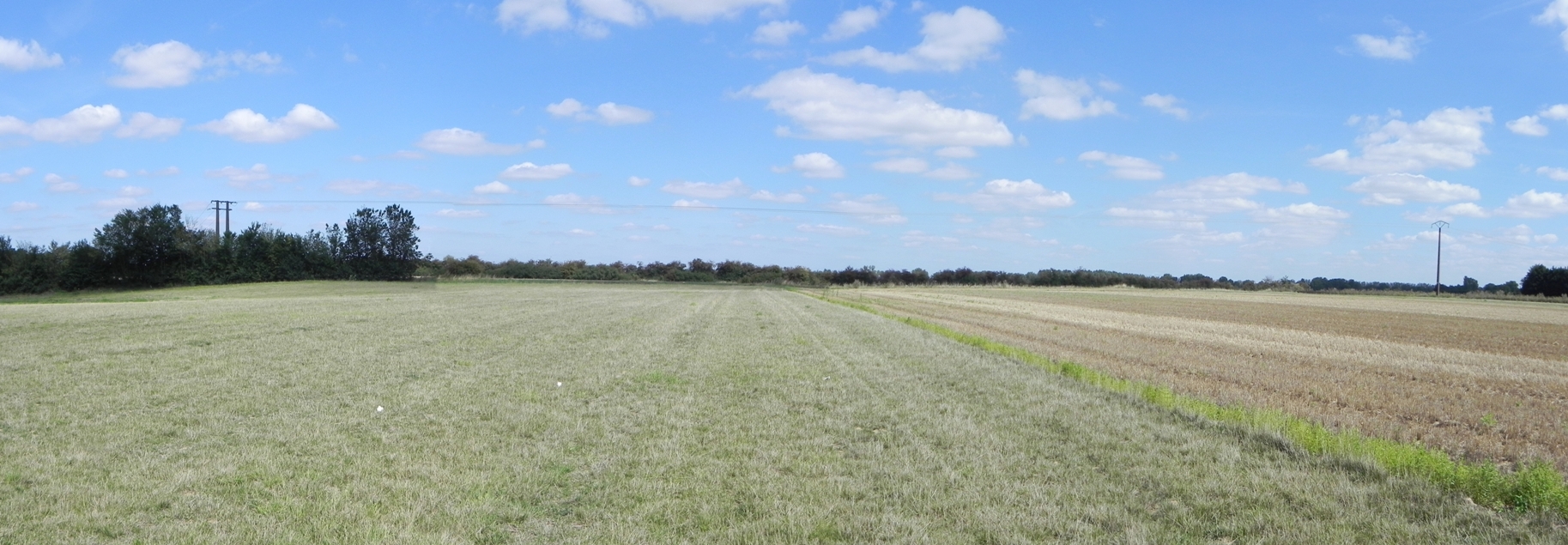
The field where Jack Davies performed the deeds which led to his VC award. German troops had crossed the canal and were coming directly towards this spot.
According to the after-action report compiled in the war diary it was in these two innocuous fields that Jack Davies mounted the parapet and kept his Lewis Gun firing until overwhelmed by the advancing Germans.
For most conspicuous bravery and devotion to duty under heavy rifle and machinegun fire. When his company – outflanked on both sides – received orders to withdraw, Corporal Davies knew that the only line of withdrawal lay through a deep stream lined with a belt of barbed wire, and that it was imperative to hold up the enemy as long as possible.
He mounted the parapet, fully exposing himself, in order to get a more effective field of fire, and kept his Lewis gun in action to the last, causing the enemy many casualties and checking their advance. By his very great devotion to duty he enabled part of his company to get across the river, which they would otherwise have been unable to do, thus undoubtedly saving the lives of many of his comrades. When last seen this gallant N.C.O. was still firing his gun, with the enemy close on the top of him, and was in all probability killed at his gun.
Quite how and why he wasn’t killed remains unknown but it was only two months later, after his VC citation had been published in the London Gazette that word reached home that he was a POW in Germany. It was safely assumed that Jack was killed in the action and so the citation (above) is written as a posthumous record of his bravery.
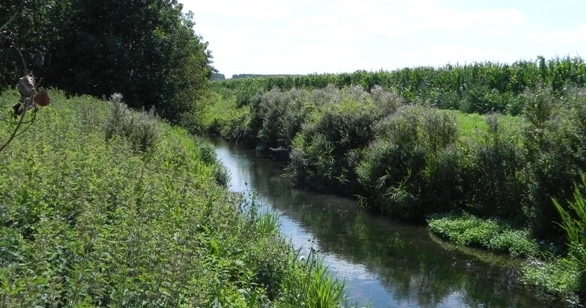
The "deep stream lined with a belt of barbed wire" over which the survivors of the 11th South Lancs escaped - now called the River d'Allemagne.
Roland laid a small cross in the field and we then paid our respects at Ham British Cemetery where other men of the 11th South Lancs who hadn’t the same luck as Jack are buried. It was a spot I hadn’t visited before and I was taken by the two cemeteries – the British and Commonwealth cemetery directly next to the Muille-Villette German Cemetery.

Ham British Cemetery. The black crosses of the neighbouring German cemetery can just be made out above the Portland stone headstones.

A view from the German cemetery - the gravestones of German and British soldiers lie almost side-by-side.
Before leaving I laid a cross at the grave of Lieutenant John Cuthbert Lidgett, 11th South Lancs in memory of all the men of the battalion who made the ultimate sacrifice. It had been a real trip to remember….
“What a wonderful day you provided for me, far exceeding my expectations for our time together. I mentioned the words ‘bringing alive’ and certainly you did that both for the 1 July 1916 action on the Somme and also Jack’s story from 21-24 March 1918. I have no idea how many similar stories you have so far put together, but I cannot think that anyone trying to trace the steps of a long lost relative would regret having made contact with you. If this is the source of your livelihood, then I can see nothing but success ahead.” Roland Parr, Cambridge
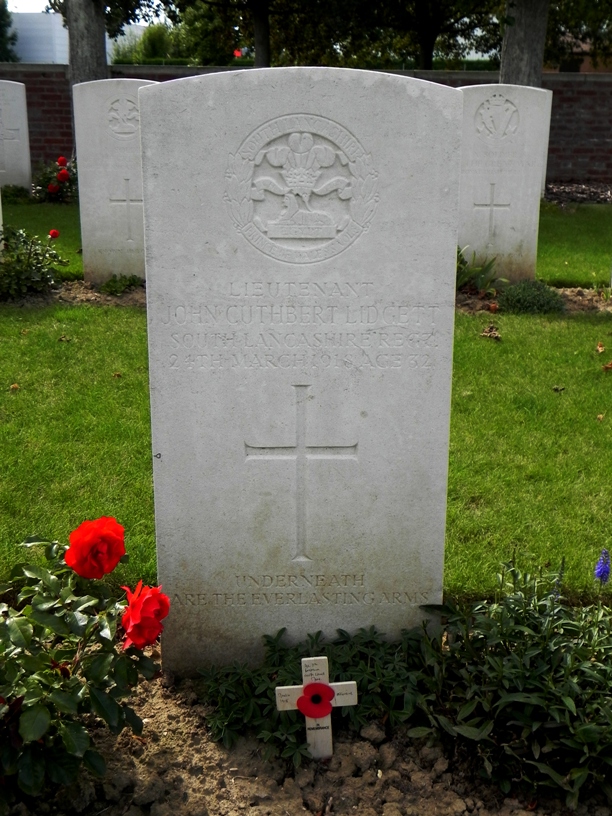
The grave of Lieutenant John Cuthbert Lidgett, 11th South Lancs in Ham British Cemetery. The cross was placed in memory of all the men of the battalion who made the ultimate sacrifice.
What a wonderful day you provided for me, far exceeding my expectations for our time together. I mentioned the words ‘bringing alive’ and certainly you did that both for the 1 July 1916 action on the Somme and also Jack’s story from 21-24 March 1918. I have no idea how many similar stories you have so far put together, but I cannot think that anyone trying to trace the steps of a long lost relative would regret having made contact with you. If this is the source of your livelihood, then I can see nothing but success ahead.
Roland Parr,
Last week I spent an enjoyable two days on the battlefields with four clients. For all but one of them it was their first visit to the western front. We met bright and early on Monday morning at the Channel Tunnel terminal and travelled over in convoy down to Arras.
Arras
Our first stop was in the superb Carriere Wellington. Our guide, the irrepressible Pascal, was as keen as ever and coupled with my preliminary talk on the Battle of Arras and the ten minute ‘taster’ film shown prior to going underground my group got a good initial grasp of the battle in April & May 1917. Following our hour underground we visited the Arras Memorial to the Missing and Faubourg d’Amiens Cemetery. The sheer scale of men with no known grave from the Arras battlefields had the usual sobering effect.
Being so close we popped into the Mur des Fusillés and paid our respects at the site where 218 French resistance and civilians were shot by the Germans in the Second World War. I have always found it an eerie place with a strange atmosphere all of its own.
We then headed out to the Great War battlefields around Arras with the first stop the Point du Jour for a visit to the military cemetery and the graves of the 10th Lincolns men (Grimsby Chums) found in 2001 and the impressive 9th (Scottish) Division memorial re-sited next to the cemetery. After a picnic lunch in the cemetery we headed back into Athies and along to Fampoux. The village marked the point of furthest advance into German lines on 9 April 1917. We stopped at the sunken lane to look at the attack of the 2nd Seaforth Highlanders and 1st Royal Irish Fusiliers (10th Brigade, 4th Division) against Greenland Hill and Roeux on 11 April 1917. Whilst at the Sunken Lane Cemetery overlooking the sloping fields down to Roeux I told my group of Donald MacKintosh and the actions that earned his Victoria Cross. We then drive through Roeux past the site of the Chemical Works (now a Carrefour mini-supermarket) and around to Brown’s Copse Cemetery to pay our respects at MacKintosh’s grave.
Back on the road we crossed the Scarpe and headed up to Monchy-le-Preux. I pointed out the positions of various trench lines and explained about the catastrophic failure of the 3 May attack, the Third Battle of the Scarpe. We then had a drive around Monchy, stopping at the stunning 37th Division memorial and the Newfoundland Caribou Memorial which is built on the top of a British artillery observation post constructed in August 1917 by 69 Field Company RE. Our day’s battlefielding was completed with a stop east of the village on Infantry Hill where I told of the disastrous 14 April attack by 1st Essex Regiment and the aforementioned Newfoundlanders. Both battalions were destroyed in carefully planned German counter-attacks – the first use of the new doctrine of ‘elastic’ defence. Monchy was at the mercy of the Germans and the situation was only saved by the quick thinking action of Lt-Colonel James Forbes-Robertson and a small group of men – all decorated for this action and known thereafter as the Heroes of Monchy.
We had a pleasant walk up Infantry Hill to the Mound and then headed back into Arras to pick up my car and then headed down to the Somme for a welcome meal and good night’s sleep.

The view of Infantry Hill from Green Lane. Bois du Vert sits on the horizon to the right of the picture.
The Somme
The next day was spent touring the 1916 Somme battlefield. Very much aware that one can only skim over the surface with one day around such a large and important battlefield we were up early to make full use of the daylight. After an explanation in the car park on the battle using various maps we set off north up to Serre, the most northerly point of continuous attack on 1 July 1916. En route we pulled the car in at the Ulster Tower for a view across the Ancre and an explanation of events in the northern part of the battlefield. The Gospel Copses at Serre were deserted and we had Sheffield Memorial Park all to ourselves as I explained about the failure of the attack and the losses incurred by the northern Pals battalions of the 31st Division.
After some time in Railway Hollow Cemetery we stopped at Serre Road Cemetery No.2 (the largest on the Somme battlefield) and the across the Redan Ridge to Beaumont Hamel, and the infamous sunken lane, the jumping off point for the 1st Lancashire Fusiliers that fateful morning. We then retraced our steps and stopped for a pleasantly quiet walk around the preserved trenches of Newfoundland Memorial Park with its Caribou and even more imposing memorial to the 51st (Highland) Division, conquerors of Beaumont Hamel in November 1916. Our next stop was to the magnificent Thiepval Memorial to the Missing, a must for any battlefield visitor to the western front. Heading via Pozières of Australian fame we reached the Old Blighty Tea Rooms at La Boisselle for a deserved late lunch.
The afternoon began with a detailed tour around the Glory Hole at La Boisselle and a good walk around the site looking at the craters and depressions marking the trenches followed by a stop at the unmissable Lochnagar Crater.
We then headed east through the battlefield, past Contalmaison, Longueval and Guillemont to the Cedric Dickens cross at Ginchy overlooking Leuze and Bouleaux Woods. This was a special stop for one of the group whose grandfather had served with the 1/8th Middlesex Regiment and who had probably been in these very fields in mid-September 1916.

Jack & John with Bouleaux Wood in the background. John’s grandfather served here in September 1916 with the 1/8th Middlesex Regiment.
Our final stop of the day was to the site above Mametz of our successful archaeological dig for a Livens Large Gallery Flame Projector where I could stand my clients on the spot where the parts had been recovered in May 2010. Sadly we did not have time to all visit the Historial de la Grande Guerre at Peronne to see the temporary exhibition and salvaged projector parts as well as the full size replica but there is only so much we could do within the time constraints.
“I would just like to say a big thank you for making our battlefield tour such an interesting and amazing event. Your knowledge of the area and what went on and where, is just incredible. The tour was made that much better by the fact that you had researched my Grandfather’s service in the Middlesex Regiment and proceeded to show us exactly where he was and what he would have experienced almost to the day but 95 years ago. It made the hair stand up on the back of my neck!
The choice of locations that you picked were excellent, and whilst I know two days is not long enough to cover everything there is to see, we certainly got a very good understanding of what happened, by whom and where. This was made even more poignant by linking them to my ancestors who had fought there. I would have no hesitation in recommending your tours to any of my friends, in fact I have told them of my experience with you and we are already planning another tour for next year.” John Waterman, Kent
It was a terrific trip with delightful people who have clearly got the battlefielding bug. My thanks to John, Clare, Sally and Jack for their enthusiasm, understanding and for sending me a selection of photos. I am already looking forward to the next time…

